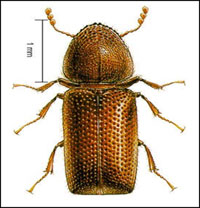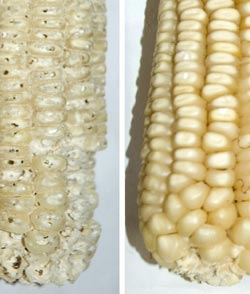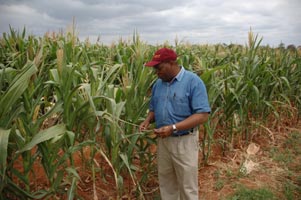CIMMYT E-News, vol 4 no. 9, September 2007
 The larger grain borer is taking a beating from CIMMYT breeders in Kenya as new African maize withstands the onslaught of one of the most damaging pests.
The larger grain borer is taking a beating from CIMMYT breeders in Kenya as new African maize withstands the onslaught of one of the most damaging pests.
Scientists from CIMMYT, working with the Kenya Agricultural Research Institute (KARI), have developed maize with significantly increased resistance to attack in storage bins from a pest called the larger grain borer. In just six months this small beetle can destroy more than a third of the maize farmers have stored. The new maize varieties, which dramatically decrease the damage and increase the storability of the grain, will be nominated by KARI maize breeders to the Kenya national maize performance trials run by the Kenya Plant Health Inspectorate Services (KEPHIS). The same varieties will also be distributed for evaluation by interested parties in other countries through the CIMMYT international maize testing program in 2008.
“This is a major achievement and will be of great help to farmers in Kenya and more than 20 African countries, who have had few options to control this pest for nearly 30 years” says Stephen Mugo, the CIMMYT maize breeder who headed the CIMMYT-KARI collaboration, which has been funded in part by the Syngenta Foundation for Sustainable Agriculture.
The larger grain borer, native to Central America, was first observed in Africa in Tanzania in the late 1970s and early 1980s. A particularly severe drought struck eastern Africa in 1979 and there was little local maize. The world responded with large shipments of maize as aid. The borer may well have been an uninvited guest in a food aid shipment.
 Even in Latin America, where it has co-evolved with natural predators, losses are significant. In Africa, where there are no similar predators to control the insect, its spread has been most dramatic. Attempts to introduce some of those predators to Africa to control the borer (a technique called biological control) have met with limited success and regionally concerted action is essential if biological control is to be effective across borer-infested areas. Researchers also studied the habits of the borer, hoping to find ways to reduce the damage it does. They discovered that it needs a solid platform, such as that provided by maize kernels still on the cob, before it will bore into a kernel. Unfortunately African farmers often store maize on the cob, increasing the potential for borer damage. By shelling the maize and storing the kernels off the cob, the damage can be reduced by small amounts, but losses are still very high. This is what makes the development of new varieties, where the resistance lies in the seed, so exciting.
Even in Latin America, where it has co-evolved with natural predators, losses are significant. In Africa, where there are no similar predators to control the insect, its spread has been most dramatic. Attempts to introduce some of those predators to Africa to control the borer (a technique called biological control) have met with limited success and regionally concerted action is essential if biological control is to be effective across borer-infested areas. Researchers also studied the habits of the borer, hoping to find ways to reduce the damage it does. They discovered that it needs a solid platform, such as that provided by maize kernels still on the cob, before it will bore into a kernel. Unfortunately African farmers often store maize on the cob, increasing the potential for borer damage. By shelling the maize and storing the kernels off the cob, the damage can be reduced by small amounts, but losses are still very high. This is what makes the development of new varieties, where the resistance lies in the seed, so exciting.
“Having the solution in the seed itself makes adoption much easier for farmers,” says Marianne Banziger, the director of CIMMYT’s Global Maize Program. “There is no added workload or expense to the farmer, no longstanding practices or habits to change.” But Banziger cautions that resistant maize is not a silver bullet solution to the grain borer problem. “We strongly encourage the use of the new varieties in combination with other measures,” she says. “The varieties are more resistant but as time progresses there will still be some damage, though much less than before.”
 CIMMYT researchers found resistance to the borer in the Center’s germplasm bank, in maize seed originally from the Caribbean. The bank holds 25,000 unique collections of native maize races. By using conventional plant breeding techniques, crossing those plants with maize already adapted to the conditions found in eastern Africa, Mugo and the breeding team were able to combine the resistance of the Caribbean maize with the key traits valued by Kenyan maize farmers. The maize was tested for resistance at the KARI research station in Kiboko, Kenya. Larger grain borers were placed in glass jars with a known weight of maize. Weight changes to the maize and a visual assessment of damage were recorded, allowing researchers to select the best lines. The result is new maize varieties that will benefit farmers in Kenya and help reduce Kenya’s dependence on imported maize for national food security.
CIMMYT researchers found resistance to the borer in the Center’s germplasm bank, in maize seed originally from the Caribbean. The bank holds 25,000 unique collections of native maize races. By using conventional plant breeding techniques, crossing those plants with maize already adapted to the conditions found in eastern Africa, Mugo and the breeding team were able to combine the resistance of the Caribbean maize with the key traits valued by Kenyan maize farmers. The maize was tested for resistance at the KARI research station in Kiboko, Kenya. Larger grain borers were placed in glass jars with a known weight of maize. Weight changes to the maize and a visual assessment of damage were recorded, allowing researchers to select the best lines. The result is new maize varieties that will benefit farmers in Kenya and help reduce Kenya’s dependence on imported maize for national food security.
Testing by Kenya Plant Health Inspectorate Services and by national seed authorities in other countries is expected to take 1-3 years, after which seed of the new maize hybrids and open pollinated varieties will be available to seed companies for seed production and sale to farmers.
For more information: Stephen Mugo, Maize breeder (s.mugo@cgiar.org)
 Nutrition, health and food security
Nutrition, health and food security 
